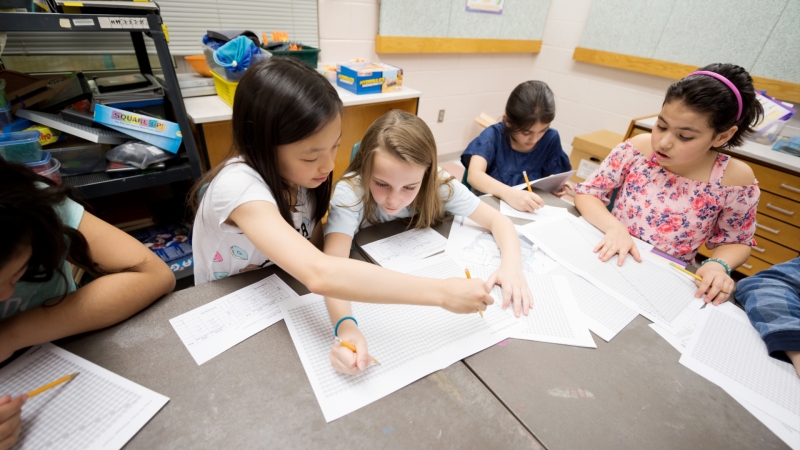
STEAM and Computer Science Program Improvement and Innovation Plan
Relevant details and data for the STEAM and Computer Science Program
Program Overview
Science, Technology, Engineering, Arts, and Mathematics (STEAM) and Computer Science (CS) are important for all students in preschool through grade 12. The Virginia Department of Education (VDOE) Science Standards include engineering practices in all grades. The VDOE CS Standards include the expectation for schools to integrate CS in grades K-8. STEAM and CS:
- Support learning across content areas.
- Accelerate growth in Portrait of a Graduate (POG).
- Increase access to rigorous academic learning.
- Support social emotional learning (SEL).
- Support the FCPS Get2Green Initiative.
- Prepare students for academic and career success.
- Advance FCPS strategic goals.
STEAM integrates content areas:
- Students apply Science concepts to define and solve problems.
- Technology and computer science help optimize solutions and bring ideas to reality.
- Engineering practices are used across content areas to design and test ideas.
- Arts practices and creative expression enhance designs.
- Math is used to understand the problem, make predictions, and design solutions.
Through STEAM, students build engineering practices. Students:
- Define a problem and apply computational thinking to design and optimize solutions.
- Ask questions and carry out investigations with an inclusive, iterative design process.
- Use data, evaluate information, and develop models to make their thinking visible and communicate.
- Collaborate with peers to critique and refine ideas and deepen understanding.
Through Computer Science, students develop computational thinking and programming practices. Students:
- Apply computational thinking to solve problems with or without technology. They break apart complex problems, look for patterns, simplify, and sequence.
- Use code to express ideas and become creators of technology.
- Create, test, and refine solutions using a computer.
- Develop POG attributes and prepare for future careers.
Both CS and STEAM empower students to explore real world problems and see themselves in careers of the future.
Scope of Impact
STEAM
| School Year | School Level | Number of Sites | Number of Students |
|---|---|---|---|
| 2021-22 | Early Childhood* | Data not available | Data not available |
| ES | 103 | 50,572 | |
| MS | 26 | Invalid Data | |
| HS | 24 | Invalid Data | |
| 2022-23 | Early Childhood* | 75 | Approximately 3,600 |
| ES | 119 | 84,917 | |
| MS | 26 | 8,943 | |
| HS | 24 | 4,698 | |
| 2023-24 (projected) | Early Childhood* | 95 | Approximately 3,900 |
| ES | 121 | 86,600 | |
| MS | 26 | 9,122 | |
| HS | 24 | 4,792 |
* NOTE: Early Childhood Data reflects 100% of schools and centers that have Early Childhood Resource services, Early Childhood Class Based Services, Pre-K classes, and Early Head Start classes.
Computer Science
| School Year | Grades | Number of Sites | Number of Students |
|---|---|---|---|
| 2021-22 | Early Childhood | 9 | 157 |
| ES | 80 | 32,049 | |
| MS | 25 | Invalid Data | |
| HS | 26 | Invalid Data | |
| 2022-23 | Early Childhood | 14 | 192 |
| ES | 114 | 54,116 | |
| MS | 25 | 3,619 | |
| HS | 26 | 8,979 | |
| 2023-24 (projected) | Early Childhood | 20 | Approximately 250 |
| ES | 116 | 55,200 | |
| MS | 26 | 3,691 | |
| HS | 26 | 9,159 |
Goals, Actions, and Measures
By the end of the 2023-24 school year (SY), increase Early Childhood Special Education (ECSE) and PreK student participation in Computer Science (CS) by establishing a model for CS integration. Maintain 100% student access in STEAM.
Actions
- Provide support to schools, professional learning, curriculum, career experiences, and hands-on learning resources for preK-6.
- Collect annual data on early childhood student participation in STEAM and CS.
Measure
Number of students participating in STEAM and CS.
By the end of the 2023-24 SY, increase K-6 student participation in STEAM and CS by 2%.
Actions
- Provide support to schools and expand access to professional learning, career experiences, and instructional resources for K-6.
- Collect annual data on K-6 student participation in STEAM and CS.
Measures
- Number of schools with STEAM and CS Specials.
- Number of students participating in STEAM and CS.
During the 2023-24 SY, increase by 2% grades 7-12 student enrollment in STEAM and Computer Science (CS) courses. This includes a similar increase in enrollment of students underrepresented in STEAM and CS courses.
Actions
- Provide support to schools, professional learning, educator collaboration, career-aligned course pathways and career experiences grades 7-12.
- Collect annual data on grade 7-12 student enrollment in STEAM and CS courses.
Measure
Number of students participating in STEAM and CS electives.



